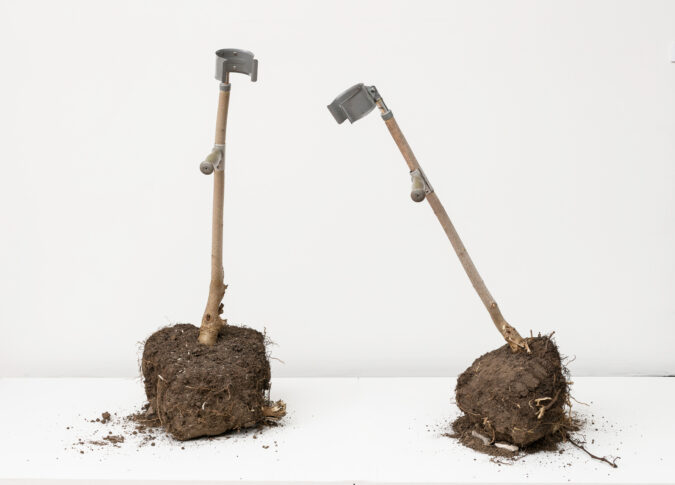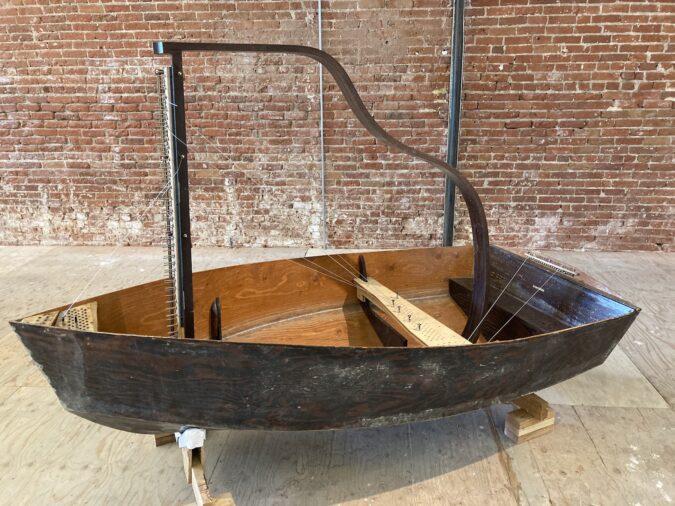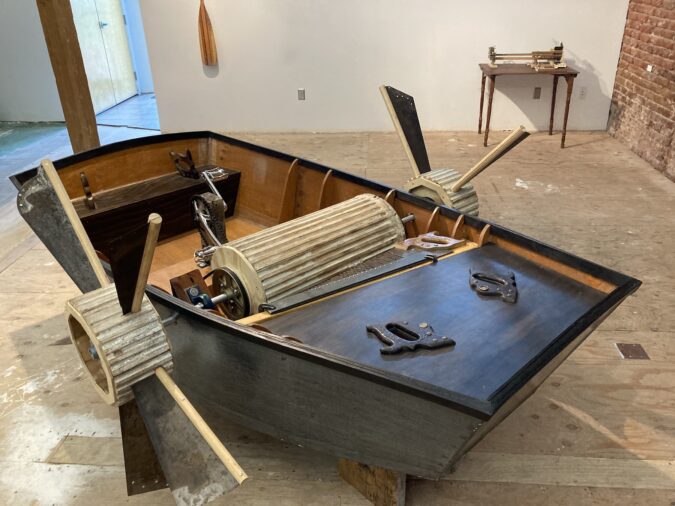Alex Branch
Alex Branch is an interdisciplinary artist whose work often requires or implies the involvement of a human body to activate and realize the piece. The objects and installations she makes can be architectural, acoustic, kinetic. A person can be housed inside them, traverse the water in them. They can be worn or flipped through. They can be played or simply looked at but even in the looking, the body is imagined.
Question:
When discussing your work, you refer to transformation and the unexpected relationship between things. Can you expand on this and where the ideas for your work come from?
Answer:
I think my interest in transformation can be traced back to my childhood growing up on an island in the Pacific Northwest. As a child, I was fascinated by the mysterious objects that would wash ashore from unknown places, some from the natural world, and also those that were human made but had been transformed by their time in the water. Barnacles and seaweed would attach to them, changing them into hybrids. When I work with found objects in the present day, they carry with them a residue of a life lived. It’s not possible to know exactly where the objects have been, or who interacted with them, but the fullness and richness of their experience resonates.
Ideas can be elusive and can come to me in ways I don’t anticipate. There are periods of time when there are no clear ideas and it can feel like I’m scratching around looking for a scent, but once I finally catch the scent of an idea there’s a propulsion that happens. Likewise, I can be drawn to an object but not know why or where that attraction will lead. That happened with the process of making the Sapling Crutch sculpture that’s part of the medical equipment series I made while doing a residency in Denver in late 2018. I had a view of a construction site out the window of my studio, where the scene changed every day. One morning the construction workers pulled up two saplings and left them on the sidewalk. For days, I kept looking out the window at them. Their massive root balls were beautiful and strange. The way they looked, uprooted on the sidewalk, was so compelling I kept thinking about them, but before I had the chance to bring them into my studio, the saplings disappeared. Of course once they were gone was when the idea came to me to transform the saplings into forearm crutches. The thin trunks would be the crutches themselves, fitted with the support hardware. The idea was then so clear that I had to find another pair of saplings, so I went by other construction sites, called tree removal services……none of those avenues worked. Finally I found someone who had saplings in their yard that were crowding other plants and needed to be removed. I excavated them in the cold frozen ground of winter to make the piece.
An idea doesn’t always originate in a specific physical object, sometimes it can come from the conceptual ideas surrounding it. That’s what happened with the Tumbling Tumbleweed piece I made in the fall of 2020. I first encountered tumbleweeds in western films, and was drawn to them for their symbolic elements: a kind of American western freedom, rootlessness, the rambling loner. In a more physiological manner, it’s interesting that the plant is dead but can move, traveling across the landscape, making it appear like it’s a living entity when it’s actually not alive at all. The way it moves crosses the line from rooted plant to untethered animal, but this movement is a mirage that’s actually caused by the wind. There is a duality of life in death contained in the tumbleweed. The plant is dead, but in its death it’s spreading seeds and creating new life. For these reasons, the tumbleweed has always had a place in my imagination and I’ve done experiments with them over the years. Then I got an idea to have a tumbleweed tumbling in place on a treadmill. For me, there was something funny about that image, a tumbleweed rambling and not actually getting anywhere. Funny and a little sad. I had that idea percolating in my mind for years, and then In the process of finally making the piece and doing research for it, I discovered that the tumbleweed actually originated in Russia, only coming to the United States in the 1880s. It’s believed that the seeds were accidentally mixed into shipments of flax flour and then made their way into the soil in the Dakotas. They then grew, died and tumbled around the country spreading their seeds. This research led to a collaboration with Chicago based musicians Justin Brown and Phillip Strosberg who translated and recorded a Russian version of the old time ballad “Tumbling Tumbleweeds”.
In 2015, I had the opportunity to make a piece for a group show on a steamship moored in the Hudson River. Because I wanted to make a site specific piece, I spent a great deal of time on the ship. When I was in the hull of the boat, I was struck by the way sound resonated inside the chamber. The sounds from outside the vessel, like the lapping waves and sounds of motorboats, were amplified inside it. This happened with sounds produced inside the boat as well. The experience was what I imagine it would be like to be inside the body of a cello. I saw other relationships between the ship and musical instruments as well. For instance, the rigging lines above deck resembled stringed instruments and the lines made sound when moved by the wind. The ship was musical in itself, but the time I spent on the boat then sparked the idea to intentionally make a series of boats that were both musical instruments and functioning water vessels that could be played by musicians as well as by the wind and motion of the water. So, I did a lot of research on boat building techniques and also corresponded with a boat builder based in Maine. I was living in New York City at the time and space was difficult to come by so I was also looking for a location where I could build the boat. A location in relation to a specific waterway.
I built the first boat in New Mexico for the Rio Grande using the stitch and glue method of boat building and also using parts of a grand piano I found in the desert and disassembled. It’s a stringed instrument that can be played with a bow or plucked. The body has percussive qualities and acts as a resonator. I’ve collaborated with a number of musicians who have performed on the boat and it can also be played by the wind when on the water. The second boat in the series is a paddle wheel boat that I built in St.Louis for the Mississippi River. I saw a similarity between the paddle wheel boats that traveled up and down the river and the mechanism of the music box and built a boat that is a combination of the two. Struck by the architecture in the area, I used architectural elements in the construction of the boat as well as found and repurposed materials. Building the fleet is an ongoing project that has spanned 7 years and varied landscapes.









Beautiful, timeless work!